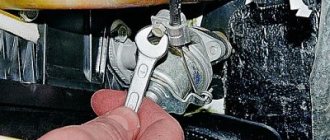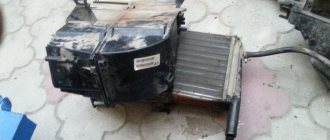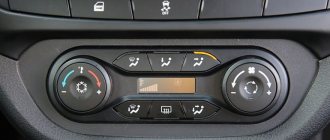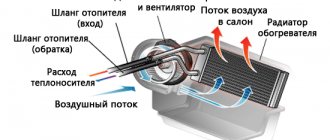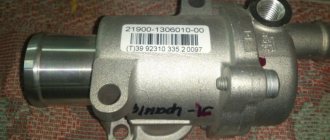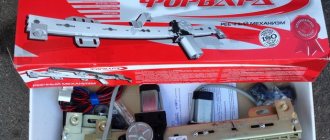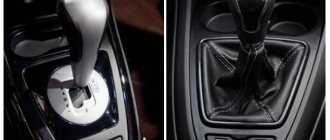Content
How to insulate a car radiator for the winter is a rather multifaceted question; there are several different ways to carry out this work. At the same time, there are several myths circulating among drivers about this modification of the cooling system. Despite the fact that they are not true, these myths are quite tenacious and popular:
- Reducing fuel consumption by 20% when using special protective equipment. This myth is inspired by the advertising efforts of manufacturers of such insulation. In practice, of course, fuel consumption is slightly reduced due to faster warm-up. But the savings are much lower. But such kits are very expensive;
- Insulating the radiator makes it easier to start the engine in the morning. If your car has been parked for only a couple of hours, the insulation will retain some of the heat, and the engine will start faster and easier. Having stood in the cold all night, the engine will cool down even with very good insulation. Therefore, insulating the radiator will not give you any advantage when starting up.
Now that you have become familiar with the mythology of insulating the radiator and engine compartment, you can begin the actual work of protecting this part of the car from the cold.
Why is the radiator closed on old cars?
The tradition of closing the car radiator for the winter appeared quite a long time ago. To understand the need for such a procedure, you need to remember the mechanism of operation of the radiator on machines that appeared on the market in the late 80s and earlier. In such cars, the radiator was cooled by a fan due to a belt drive from the crankshaft, which spun the fan. Accordingly, the higher the car's speed, the faster the fan rotated and the radiator received more cooling.
The disadvantages of such a cooling system were obvious - the inability to control the operation of the fan at different ambient temperatures. In other words, even in cold winter, when the car was moving at high speed, the fan was spinning strongly. Because of this, problems arose in the operation of the engine. The engine did not warm up to the required operating temperatures, which could cause various malfunctions. In summer, such cooling was also not effective. At high speed, the engine managed to cool down, but at idle it often overheated, since the high ambient temperature and low fan speed did not have time to reduce its temperature to operating temperature.
Based on the above, it becomes clear that in winter it was necessary to limit the cooling of the radiator by counter-flow of air, especially in severe frost. To do this, cardboard boxes were installed that did not allow air to pass through, and the radiator was cooled only by a fan when the car was moving.
Theoretical knowledge
It is better to learn how to properly install insulation from experienced drivers who have been driving for several years. There is nothing difficult in this operation, but still, the advice of experienced craftsmen will definitely not be superfluous. You should be interested in why this is necessary at all only after mastering this insulation technology. Making the right decision and the chosen insulation method makes it possible to evaluate all the advantages and benefits of engine insulation.
Similar articles
DIY engine insulation
If you restrict the air flow to the grille, you will receive the following benefits:
- When driving at high speeds, heat will remain in the engine compartment.
- The desired coolant temperature is quickly reached, the engine quickly reaches a sufficient temperature, and this will warm up the air in the car’s interior faster.
- Even when driving short distances, the engine will warm up faster.
Rating of the best insulation materials
The list of insulation products for cars that drivers used was created based on reviews.
The most frequently purchased insulation materials are blankets from the brands TORSO, STP HEATSHIELD, SKYWAY, “Avto-MAT” and “Avtoteplo”:
- Car blanket for TORSO engine (Torso) . The cost of this insulation is lower than that of others. A blanket for cars measuring 1.3 x 0.8 meters costs approximately 500 rubles. Shelf life: 3 years. Weight: 1 kilogram. Item number: 1228161. Crossovers and high-performance SUVs require a larger size car blanket.
- Blanket STP Heat Shield (STP Heat Shield) . It costs about a thousand rubles. Attaches with 8 clips. There are sizes 1.35x0.6 meters, 1.35x0.8 meters. The blanket includes: non-woven fabric, which is stable and not corroded by oil, temperature, antifreeze, antifreeze;
- heat-absorbing and noise-absorbing layer;
- adhesive heat-resistant layer.
Additionally
Those who have decided to make the radiator insulation as serious as possible should also pay attention to additional materials for gluing the partition between the engine part and the passenger compartment, as well as the side surfaces. Such a procedure will require significant financial costs.
However, the result is worth it. All pre-processed parts must be cleaned and degreased. It will also be necessary to dismantle all insulated equipment. How necessary and advisable this is is up to you to decide.
The most optimal way to insulate the engine compartment is the comprehensive use of the methods indicated above in the review. When installing thermal insulation, certain nuances must be taken into account. All insulation elements should be securely fixed to avoid their deformation and peeling under the influence of head winds. Otherwise, this may cause a serious malfunction of the power unit after parts of the material get into the belt, generator or pump section of the engine compartment.
What does this give?
Firstly, thermal insulation of a car engine is a chance to reduce the time it takes to warm up the main unit and thus save a significant amount of fuel.
Secondly, high-quality insulation eliminates the appearance of ice on the hood, which negatively affects the paintwork.
Thirdly, the arrangement of the interior allows you to increase the efficiency of the stove and retain heat in the cabin much longer (thanks to athermal tinting, this effect can be enhanced).
Selection of thermal insulation materials for a car
How effective the procedure for insulating a car is is known first-hand by those who have already managed to take steps to improve the thermal insulation parameters. The process under consideration is achieved through the use of special materials that have such a parameter as a low level of thermal conductivity.
The insulation process involves reducing the thermal conductivity of not only the interior, but also the engine compartment. The preferred insulation materials are:
- Foampropylene.
- Biomast.
- Isotonu.
- Felt.
- Foamed polyethylene.
The insulation process should begin only when insulation materials have been purchased. The process of thermal insulation itself can be conditionally divided into two stages - insulation of the engine compartment, as well as the interior. By the way, it is recommended to start directly from the engine compartment, which will allow you to “get your hands on it.” What are the processes of insulating the engine compartment and interior of a VAZ 2107 car, we will find out further.
Similar articles
Changing the cooling radiator of a VAZ 2114 with your own hands
Refinement of the engine compartment
It is recommended to start the insulation process with the engine. This is done so that in winter the engine warms up faster and also maintains its operating temperature when the air temperature drops. The faster the engine reaches operating temperature, the sooner you can turn on the interior heater to warm it up.
Insulating a VAZ 2107 car with your own hands should begin directly from the hood. This process is performed in the following order:
- The insulation should be placed in the hood openings between the reinforcing profiles. To cut pieces of insulation into suitable shapes, you need to use templates that can be made from newspapers or cardboard.
- Before gluing the insulating material, you must first thoroughly clean and degrease the surface.
- Depending on the material used, they should be applied according to the instructions. To do this, you need to remove the protective film from the adhesive side of the material, and then, using a hair dryer (not a household hair dryer), warm up the adhesive part of the insulation.
- The quality of insulation adhesion depends not only on the heating of the adhesive composition, but also on squeezing out air from under the material.
- Insulation for the VAZ 2107 radiator is also used. To protect the radiator grille from the cold, it is necessary to use a special sheet of insulation. This sheet is attached directly to the grill itself.
Ready-made kits
In auto parts stores you can find various kits for insulating the engine and radiator for the winter. The advantage of such an acquisition is that there is no need to independently select materials and adjust them. But this approach also has disadvantages. First of all, the cost is quite high. At the same time, they sell you simply cut insulation, packed in a bag. Exactly the same material can be purchased at any hardware store.
Another drawback is low frost protection. The materials used for such kits are far from being of the highest quality. Therefore, even at -12°C, insulating elements cannot cope. In this regard, many people strive to insulate the engine compartment with their own hands.
Insulating the radiator grille: pros and cons
The main advantage of using radiator insulation is that the engine requires less fuel to reach operating temperature. This means that you can not only warm up the car faster, but thus save fuel. Also, the advantage is that road reagents will not get on the grille, and then it will not be destroyed by corrosion.
The disadvantage of radiator insulation can be considered, in a sense, the unaesthetic appearance of the car (the subjective opinion of some car owners). So, in some cases - when using hard protective covers - the radiator grille will be covered with black plastic, which somewhat reduces the appearance of the car; in other cases - when making insulation with your own hands - the grid may look a little “collective farm”: the translucent foiled side of the insulation, materials held on by clamps, unevenly cut cardboard, etc. In this case, in principle, everything depends solely on the straightforwardness and imagination of the car owner.
Homemade radiator (and engine) insulation
Another disadvantage may be an increased fire hazard if the insulation is installed inside the engine compartment. In this way, you can hide the external ugliness of the insulation material, but increase the chances of it catching fire. Still, during operation, some parts of the car reach quite high temperatures, and if something goes wrong, a spark will appear, some insulating materials may catch fire, this should not happen on the radiator side, but you should still be careful and attentive.
Cardboard radiator insulation
Winter grille covers
If the shield is made for a specific car, then it has a hidden fastening, so the beauty of the car’s appearance will be almost unimpaired. Also, the quality of this kind of product is usually high, so such a shield will last a very long time, but for all this, most likely, you will have to pay a tidy sum.
Radiator grille shield
Radiator shields from Tammers are also in great demand. Their main advantages: low cost, and installation takes little time. The fastenings are designed for quick installation, so they are clearly visible from the outside, and some motorists who are very concerned about the appearance of their swallows do not like this.
Radiator insulation “Tammers”
Now there are a huge variety of shields and insulation on the market, so it’s quite difficult to choose. When searching, you should definitely pay attention to the cost and quality of the product. If you buy a plastic shield, then its cost will be approximately 500-600 rubles. A waterproof and impact-resistant mask made of synthetic fabric will cost 2000-3000 rubles.
Insulation awning for radiator grille
Modernization and improvement of the stove
While processing the interior, you should immediately check the functionality of the heating system. On the VAZ-2107, the heater design has some design flaws. In addition, over time, the seals of the housing and air ducts cease to perform their function, which leads to the dissipation of the flow of warm air.
The main design flaw in the VAZ-2107 is insufficient fan characteristics (power, number of revolutions). To eliminate this drawback, you can replace the standard electric motor with an electric one. the motor is from a VAZ-2108, but for this you will have to slightly modify the fan housing. But we note that in addition to the motor, you need to immediately change the fuse and rheostat.
A more significant modification is the installation of a VAZ-2108 fan into the stove along with the housing (“Snail”). Such an upgrade will not only provide a powerful air flow, but will also operate more quietly.
When working with the stove, it is worth disassembling the air ducts, cleaning them thoroughly, and putting the structure back together, installing new seals. Additionally, the joints can be covered with insulating materials (the same vibration isolator) to eliminate the possibility of air leakage. The same should be done with the stove body.
If the heat exchanger of the stove warms up poorly, it may require flushing or replacement. The pipes in the interior radiator have a small cross-section, so over time they become clogged with dirt, which greatly reduces heat transfer.
If the radiator is very dirty, it is difficult to wash the dirt out of it, so in such cases it is easier to buy a new one.
Proper insulation or how to properly close the engine radiator for the winter: technologies and tips
The positive results from thermal insulation of the radiator grille are due to the fact that the engine consumes less resources to achieve and maintain operating temperature than with air cooling in winter. An additional effect is the protection of the heat exchanger honeycombs from the ingress of road reagents, which leads to an increase in corrosion resistance and preservation of the factory life of the part.
Requirements
Disrupting air cooling can cause harm. Untimely and hasty cover of the radiator grille leads to overheating of the engine. You can reduce the likelihood of thermal imbalance, and the following tips will help you do this:
- Do not lean the element directly against the radiator - there must be a gap between the heat exchanger and the thermal insulation.
- Install insulation at a temperature of -10°C or less.
- Do not cover the entire area of the heat exchange element.
Ideas
A trivial method of insulation is to insert between the heat exchanger and the bumper a piece of cardboard cut from the box of some household product to certain dimensions. A heat exchange element covered 2/3 in this way is a simple solution to the problem of how to properly close a car radiator for the winter using improvised means.
Owners of cars equipped with air conditioning will benefit from another method of insulation: insert a newspaper between the condenser and the main heat exchanger. The total thickness of the sheets should be such that they move freely between the walls of the radiators.
The disadvantage of quick methods is that they ruin the aesthetics of the front of the vehicle and are not as effective in severe frosts. However, advanced ideas require costs, but the effect is better:
- A set of dampers designed for a specific vehicle.
- External masks for radiator grilles.
- Homemade imitation of branded shields.
Factory products
Model-specific plastic covers are attached invisibly. The shape of the damper closely follows the geometry of the radiator grille and does not cover the car manufacturer’s emblem. Synthetic masks, for example, from the Tammers company, hide the architecture of the decorative sieve, and external quick-release fasteners are not to everyone’s taste.
The price of such a solution will not suit everyone. A plastic shield will cost 500-700 rubles. An impact-resistant and waterproof mask made of synthetic fabric costs about 3,000 rubles.
With your own hands
Plastics have low resistance to destruction from a suddenly thrown stone, and synthetic radiator insulation is expensive. However, the idea of quick installation itself is not entirely successful - the style suffers. These two reasons force owners to implement their own design ideas, as in the case of anti-freeze - their own recipe for a winter washer is much more effective.
Having decided that you still need to close the car radiator in winter, and you need to do it yourself, the need for materials arises. From each type of raw material you can create your own masterpiece:
- Polypropylene with a foil layer (isolon). Attaches to the inside of the bumper and grille with plastic clamps. Cut according to pattern.
- Faux leather. The cover is made according to the pattern made from the outside of the front end. Usually, braid is sewn along the contour and decorative stitches are made over the entire surface. Fastening is carried out with plastic clamps.
- Flex tubes. Suitable for gratings with horizontal ribs. A pipe of appropriate length is cut along the guide and placed on the edge.
How to close the radiator grille for the winter and when to do it
Hello everybody! The cold weather is getting closer, and therefore it’s time to discuss winter topics. Let's start with how to close the radiator grille for the winter, whether it is necessary to do this and whether there is any point in such actions.
Moreover, the question of the relevance of using this old-fashioned method will be considered in relation to old and modern cars. There is a significant difference between them, although in both cases cardboard continues to be used.
Let's find out whether it is necessary to do something like this, whether it is possible to use such overlaps at all, what this will potentially give and what problems it will save from.
And yet: is it necessary to close the car radiator in winter and the relevance of the “cardboard”
Theoretical effect
It is better to learn how to properly close the radiator for the winter from experienced drivers. There’s nothing complicated about it, but some extra advice won’t hurt. Be interested in what and how, preferably after mastering it, why it is needed and getting an answer to the question whether this method of insulation actually helps. Making a final decision is possible only if the needs of the owner and the guarantees of this method of thermal insulation coincide.
Restricting air access to the engine through the radiator grille in winter gives:
- Reducing the time it takes to fully warm up the engine during frequent short trips.
- Acceleration of coolant reaching operating temperature when warming up the power plant while driving.
- Preservation of heat in the engine compartment when driving on the highway.
Practical significance
Premium cars have long been equipped with a system of dampers that regulate the volume of air flowing over the engine. Ensuring that the power plant quickly reaches operating temperature and maintaining it within specifications helps preserve the factory life of internal combustion engine parts.
Natural thermal conditions in cold weather are only beneficial and here’s why:
- Reducing the warm-up time leads to a decrease in fuel consumption, since the ECU generates an over-rich mixture when it is cold.
- Reducing the proportion of air cooling at high speed allows the interior heater to operate at full capacity.
The help of insulation is especially noticeable at temperatures below -20°C: the computer displays suburban fuel consumption values close to summer values, and the stove heats up noticeably even at idle. This fact is confirmed by both owners of carburetor cars and owners of injectors. However, you can only get by with an additional homemade car interior heater designed for 12 Volts.
Myths
The position of companies specializing in the production of insulating components is clear. Often, when asked whether it is necessary to close the radiator in winter, they put forward additional arguments in favor:
- Fuel savings up to 25%.
- Eases cold starts.
- Increased battery life.
It is quite clear that the savings percentage is overestimated, and the closed radiator grill does not affect the morning start-up in any way - the engine managed to freeze overnight. There is also no gentle operation of the battery, since you still have to turn the crankshaft in thick oil.
Verdict
Insulating the radiator speeds up the engine's return to operating thermal conditions and helps maintain it in severe frosts, which will have a positive effect on fuel consumption and the operation of the standard stove. A simple and working way is to place a piece of cardboard in front of the heat exchanger.
A more effective measure is to cover the radiator grille from the inside with foil insulation or with dermantine from the outside: the absence of cold air blowing over the parts of the power plant helps to speed up warming up while driving. Factory-made sets of overlays and masks are no less effective, but are expensive and do not always comply with the aesthetic picture.
How to insulate?
The radiator is insulated in 2 ways. They differ in complexity of execution:
- The easiest option is to take a piece of thermal insulation and insert it in front of the radiator. This allows you to remove and install insulation if necessary without wasting extra time;
- Other drivers place insulation in front of the false radiator grille. For this purpose, a cover is sewn from leatherette. Insulation is placed in it. And all this is attached to the grille. The case should have valves that allow air access to the radiator as the temperature rises.
But insulating the radiator is not enough
You also need to pay attention to the engine. The easiest way would be to cover the inside of the hood and engine compartment with insulating material.
This will significantly reduce heat loss. Another method of insulation is to make a so-called car blanket (see the article “Which car blanket is best to choose”). For this, heat-resistant material is purchased. It is cut to the size of the engine compartment. After which the resulting “blanket” is covered with the engine. In regions with severe frosts, it would be a good idea to cover the crankcase and sides of the engine with insulation.
Conclusion
. Winter is quite a difficult time for every car enthusiast. Other inconveniences include low temperatures. Interfering with the engine's ability to operate normally. Therefore, many people wonder how to insulate a car radiator for the winter. At the same time, the insulation work is not difficult. The main thing is to do everything carefully.
Starting the engine in winter is half the battle. To warm up. The standard oven can help, but warm up the engine first. Quickly? Then the coolant preheater will help. It will also help maintain the efficiency of the heater while on the go. Expensive? Look for ways to retain heat in the cooling system. One of the techniques is based on covering the radiator grille. The experimental base is large and there are many controversies.
Why insulate the radiator grille with the onset of autumn?
This “trick” dates back to Soviet times. Cars back then weren't as high-tech as they are now. At that time there were no special engine heating systems. The fan in the cooling system worked constantly, and often did not cope with its duties.
Winters have always been quite cold; temperatures in the European part of the country could reach -35 degrees. The engine took a long time to warm up and quickly cooled down when driving along the highway or stopping. But experienced drivers came up with a way to improve engine heating by covering the radiator grill with improvised material.
But times have changed, cars have improved, and it seems that this method is no longer relevant, but this is not so. With the onset of cold weather, you can see cars with closed grilles on the city streets. And these are not only old Soviet cars, but also modern foreign cars. Why does the old “life hack” remain relevant?
- How does a modern cooling system work?
- Why insulate the radiator grille?
- Advantages of radiator insulation
- Disadvantages of radiator insulation
A little theory
First, let's look at the processes that occur in the engine compartment during operation of the power unit.
Cooling system design
The engine heats up during operation. This is due to the friction of moving parts, as well as the process of explosion of the fuel-air mixture in the combustion chamber of the cylinder head. Moving parts are naturally lubricated with engine oil to reduce the friction force between them, but lubricant is not able to completely eliminate friction. Heating still occurs.
All mechanisms have their own optimal operating temperature, at which they show maximum efficiency. Internal combustion engines are no exception. To maintain operating temperature, as well as to eliminate the possibility of overheating, the motor has a cooling system.
Modern cars use liquid cooling. The motor housing has special channels filled with coolant (antifreeze or antifreeze), which constantly circulates in the system. The power unit transfers part of its temperature to antifreeze, thereby cooling itself. The heated antifreeze enters the radiator, where it is cooled by the incoming air flow. This is the so-called “big” circle.
The “small” circle of the cooling system is similar to the “large” one. The difference is that the cooling radiator in the “small” circle is the interior heater or, in common parlance, the “stove”. If the engine temperature is below optimal, a special valve closes the channel connecting the engine with the real radiator. Thus, the coolant is not cooled by air from the street. This allows you to raise the temperature of the power unit to the working zone in a shorter time.
If, when starting the engine, the coolant temperature corresponds to the optimal value or is higher than it, the “large” circle of the cooling system immediately comes into operation. If the antifreeze temperature is lower than necessary, the thermostat valve turns off the radiator, forcing the coolant to circulate in a “small” circle.
During operation, the car engine is cooled not only by liquid cooling. This is especially noticeable when it gets very hot (during a long drive or at high ambient temperatures). In this case, the fan located between the radiator and the motor is additionally turned on. It turns out that the power unit also receives air cooling.
But it is not enough to simply “blow” on the engine to cool it. It is necessary to somehow remove the heated air from under the hood. To do this, there are ventilation holes in the design of the front of the car, between the hood and the windshield (or at the upper edge of the hood). Cold air enters the engine from the front and bottom, and hot air is discharged through special openings at the top.
So, as we see, the cooling system in modern cars is carefully thought out and tested a hundred times. That's why it works well. No action is required on our part to improve it. Yes, and this is not necessary, because... everything works like clockwork.
Heating system
Another thing is the process of heating the engine. Especially in cold and very cold seasons.
It is worth noting that there is no system for heating the engine to the optimal operating temperature. The process is entrusted to the power unit itself, or rather, to simply prevent it from cooling. Until the engine warms up properly.
As mentioned earlier, in order for the engine to warm up faster, the thermostat valve closes the cooling circuit with the radiator. In this case, the coolant passing in a “small” circle through the interior heater radiator does not have time to cool much, and the engine heats up an order of magnitude faster.
So, the engine warms up on its own. Does he need help with this, in particular, insulating the radiator?
Arguments of insulation supporters
- Insulating a car's radiator allows the engine to warm up faster.
- Insulating the radiator grille helps to warm up the interior faster.
- An insulated radiator helps maintain optimal engine temperature when driving quickly (for example, on the highway).
Let's take a closer look at these statements.
This makes the engine warm up faster
Let's imagine what will happen if you insulate the radiator grill of a car.
In severe frosts, before starting the engine, the air under the hood is at ambient temperature. During operation of the power unit, it gradually heats up. If the air heats up, then it is logical to assume that it heats up due to the fact that the heating engine shares heat with it. If the motor shares heat with something, it means that it itself cools down. Consequently, cold air under the hood in winter prevents the engine from warming up.
The heated air, in turn, heats the hood and all other parts of the car. It also vents outside through the vents and radiator. During this heat exchange with the environment, the air enveloping the engine is cooled again, and again prevents the engine from warming up quickly.
In order to minimize heat loss during engine warm-up, it is necessary to “clog” the engine compartment as much as possible and, thus, create a space isolated from the environment. To do this, you can close the ventilation holes to allow hot air to escape from under the hood, cover (for example) the engine with a “car blanket” and insulate the car radiator for the winter.
Is it worth carrying out the described procedures? I think yes. The engine should really warm up faster due to the fact that during warming up, using these measures, we minimize the flow of cold air from the outside.
This makes the interior warm up faster
The statement is true - this conclusion can be drawn by analogy with the previous statement and analysis of its validity. If you ensure maximum tightness of the engine compartment, you can hope that the engine will warm up faster. And since the car’s interior is warmed up by the engine, it is logical to assume that its warming up will occur faster. Therefore, the question of whether it is worth insulating the radiator to warm up the car interior faster can be answered positively.
This way you can maintain the optimal temperature
The question of whether it is worth insulating a car radiator in winter in order to maintain the optimal operating temperature of the engine while driving cannot be answered unambiguously. Judging by my experience (and I have never insulated anything), the engine always had an optimal 90-100 degrees when driving. True, I’m not a fan of operating a car in frosts of -30 or below.
If in your case, traveling in such conditions is necessary, and you see that at speed in cold weather the thermometer needle drops below the operating range, then the need for insulation is certainly justified.
EQUIPMENT WITH THERMAL INSULATION OF FOREIGN CARS
Budget foreign cars are popular in Russia, they differ only in better sealing and good stoves. In fact, there is no insulation as such in foreign-made cars.
It is imperative to insulate the interior of foreign cars in our cold weather. If the thermal insulation of the engine can be solved with the help of a car blanket, then the body needs to be worked on. The best insulation material is penofol with its adhesive base and foil.
We remove the decorative door trim, cut out the insulation to the required size, leave holes so as not to interfere with the moving parts inside the door, and glue the foil part outward. Everything is simpler with the trunk; by the way, there are even places for fastening insulation. Usually this treatment is sufficient.
If your region has a more severe climate, you can cover the floor with insulation and cover the ceiling of the cabin with it.
Foreign cars can be equipped with thermal protection made of vibroplast - this material not only dampens vibration, but is also a good insulator in itself. We lay them on the floor, ceiling, all doors and trunk.
To keep the engine warm, we use a car blanket, although some manufacturers offer a plastic plate to cover the radiator, but this is clearly not enough.
In conclusion, it must be said that the more carefully and thoroughly you treat the interior of your car, the more comfortable and safe you will feel on the road.
Didn't find the information you are looking for? on our forum.
Should I close it in winter?
There is no definite answer, it depends on the climate in your area and how you drive your car. You can drive on an intercity highway or around the city, the difference will be noticeable. If you have a warm climate, the weather rarely gets colder than -15 degrees, and you drive around the city, then you do not need to insulate the engine on Vesta. Otherwise, the motor may overheat.
If the frost is below -25 degrees, and you have to travel long distances, then it is better to insulate the Vesta engine. On such trips, the technological plug, oil seals or oil dipstick are often squeezed out of the motor housing. As a result, oil leaks. This happens due to long driving in the cold.
Oil vapor in the crankcase ventilation system freezes. A plug forms, which causes excess pressure. Therefore, whether to close the radiator in winter is up to you. Analyze your operating mode and make the right decision.
Methods for organizing additional insulation for the engine
Every car has a hood insulation. But this is not always enough to effectively retain the heat generated by the engine. To eliminate this problem, you can use the following methods.
Car blanket
The simplest, but not the cheapest, is to purchase a special car blanket. Previously, this method was also practiced, but old blankets or quilted pads were used. Modern products are safer, easier to use and provide better results.
Using a car blanket, you can reduce engine warm-up from 15 minutes to 10 or even 5 minutes. Saving fuel and time is obvious. The use of such an element increases the cooling time of the power unit during short stops. If a car without an insulated hood can cool down in less than an hour, then with a car blanket this time increases to 5 hours.
Car blankets are produced for Renault Logan, VAZ-2109 and many other car brands. Their installation takes a few minutes, does not require any skills, and you don’t even need tools. There is simply no easier way to insulate a hood.
The radiator grille must be closed
A lot of heat is lost through the radiator grille, which is completely unacceptable. While driving, the radiator is blown with cold air, which contributes to intense heat loss. In order for the thermal insulation to be at a high level, you need to make a closed radiator grille yourself or buy it ready-made.
You've probably seen Gazelles on the roads with cardboard on their radiators. It may not look very nice, but it effectively retains heat. If this method is unacceptable for you, then you can order and install a grille with closing blinds. Owners of Renault Logan and some other common cars can find ready-made options on the market. Unfortunately, such accessories are not produced for domestic cars, so car owners will have to make their own closed grille. There is nothing complicated about this, especially if you have the skills to work with epoxy materials and putty.
Heat from a heated engine can escape through the bottom of the body. In this case, it is necessary to install protection for the power unit. If you miss this moment and leave the engine unprotected, the effectiveness of the above methods will be significantly reduced.
Insulation yourself
The easiest option is to insert pieces of cardboard between the grille and the radiator. This allows you to slightly reduce heat loss when traveling in winter. But this is not very effective. Besides, it's not very aesthetically pleasing. Therefore, it is best to use more modern insulation methods. Please note that working with radiator insulation is not enough.
You should also pay attention to the entire engine and engine compartment. When installing, be sure to securely fasten the insulation correctly. If it accidentally gets under the generator or timing belts, you will have to make expensive repairs to these systems.
The importance of additional engine insulation
As can be seen in the photo of engine insulation, such an event means the installation of additional thermal insulation.
A nice bonus in some cases is improved sound insulation. There are also advantages:
- slower engine cooling and faster reaching operating temperature;
- increasing the level of comfort when using the machine in the winter months.
Peculiarities
Today on sale you can find special car blankets designed to insulate the engine compartment of a car.
Insulating the engine with your own hands using them is quite simple. Even a beginner can handle the procedure. If you don’t want to spend money, then you can use improvised means for this purpose.
The global market amazes with the range of thermal insulation for cars. Modern insulation can not only protect the engine, but also reduce fuel consumption.
But not all drivers are confident in the need for such work. Many consider them a waste of time and money.
In reality, it is up to you whether to carry out additional thermal insulation measures or not. In any case, you will have to make one of the following decisions:
- equip the car with autostart;
- use an engine preheater.
Thanks to such mechanisms, time is saved after a long period of inactivity in frosty weather - you get behind the wheel in a warmed-up interior.
But it is worth noting their rather high price. In addition, the automatic start system requires high fuel consumption, and the preheater will significantly reduce the durability of the battery.
Types of car blankets
Based on the material of manufacture, such products are:
- Felt. Advantage - low thermal conductivity, disadvantage - insufficient fire safety.
- Fiberglass. Advantages - financial accessibility, low heat conductivity.
- From mullite-siliceous materials. Pros: frost resistance, resistance to aggressive chemicals and temperature changes.
On the outside, the types of thermal insulation described above are covered with durable and strong non-flammable fabric that can withstand high temperatures.
The following option is also possible - the presence of a mirror film on car blankets designed to reflect heat.
Specifics of the engine insulation process
After you have decided how to insulate the VAZ engine, you need to install a car blanket. The event is simple. No knowledge or special effort is required from you.
Car insulation will pay for itself within 1 – 2 months. With its help, heat will be retained, allowing the engine to reach operating temperature.
In addition, blankets for cars are non-toxic, fireproof, resistant to all liquids used in the vehicle, and are easy to install and subsequently maintain.
When purchasing car insulation, ask the seller and carefully study the product passport and certificate of conformity.
Before paying for your purchase, check the integrity of the packaging. In addition, the package must be branded. The shelf life of the car blanket is one season.
Nuances of insulation of diesel engines
There shouldn’t be any special problems with how to properly insulate the engine for the winter with your own hands. It is enough to purchase the necessary materials and use them in accordance with their intended purpose.
At the same time, it would be fair to say that a diesel engine is more sensitive to low temperatures than a gasoline engine. This is due to increased requirements for the quality of lubricant and the characteristics of diesel fuel.
Therefore, doing the insulation of the hood and engine of a car with your own hands if you have a diesel engine should be done with special care. In this regard, experts give several recommendations:
- Take advantage of a high-quality and effective car blanket that fits the specific dimensions of your engine compartment. If the frost is severe, but the blanket only partially covers the internal combustion engine, this will not have any effect.
- The car blanket itself only partially solves the problem of motor oil solidifying. Therefore, it is almost pointless to use only it when it is -30 degrees outside.
- Additionally, insulation of the pipelines that lead from the fuel tank to the engine itself is required. For these purposes, it is effective to use foamed polyethylene with a thickness of 5 mm.
- The same material should be used to cover various cracks under the hood.
- It would be a good idea to insulate the radiator using suitable materials. The same sheets that were used to process the hood cover will also work.
A distinctive feature of diesel is that it is in greater need of comprehensive insulation. Gasoline analogs are simpler in this component.
How to insulate gasoline internal combustion engines
Now let’s talk about how to properly insulate the hood and engine of a gasoline car with your own hands.
The technology here is similar. But gasoline internal combustion engines are hotter, they do not need special winter fuel, and therefore there is no need to cover the pipelines with protective materials.
In this case, the insulation of the engine and other components of the car is carried out according to the standard scheme. Namely:
- Insulation is being installed for the engine to survive the winter. It’s important to do this yourself when the temperature outside is consistently below -20 degrees Celsius, and at night can reach -30-40 degrees. If the winter is much warmer, such events will be unnecessary. Excessive insulation can only provoke overheating, and the engine will fail.
- A more reasonable solution, which will complement the car blanket in severe winters or act as an independent way to solve the problem in moderate frosts, would be to insulate the hood lid. Any of the materials listed above are used. Just choose the thickness and cut the workpieces so that the insulator does not come into contact with the battery terminals.
- In a really harsh winter, you can supplement the listed procedures by additionally laying an insulator to protect the engine. It needs to be dismantled, cleaned and dried, and then the adhesive insulation is cut out according to the template.
Additionally, on gasoline and diesel cars the radiator grille is closed. This point can also be debated endlessly.
Excessive insulation, even in winter, can lead to dangerous overheating, so it is important to use moderation and not get carried away with insulators.
Remember that the engine needs fresh air. If all channels are blocked, the cooling system may not cope during long driving. Yes, the engine will not cool down when parked for several hours, but a lack of cooling will have the opposite effect.
